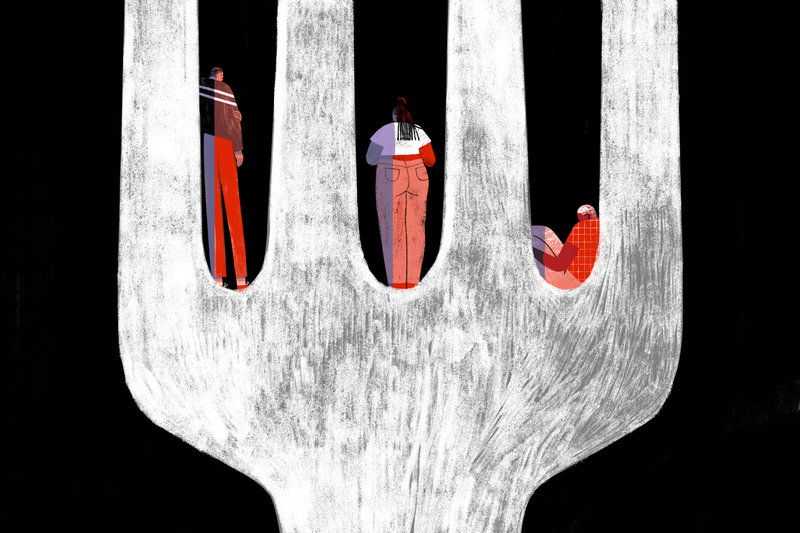A growing problem in modern technological society is that of eating disorders. Compulsive eating (also sometimes identified as binge-eating disorder), anorexia nervosa, and bulimia are the ones that we hear the most about. People who eat too much and can get fat, people who starve themselves in order to have the apparently perfect body, and people who eat a lot and then try to get rid of it by vomiting, laxatives, enemas and severe exercise. All of these are very serious conditions that are becoming increasingly prevalent all over the world. There are many levels of causation affecting the experience of these disorders. But I am particularly interested in the causes that are not normally covered in talking about them: the growing amount of numbness that people feel from living in an overly frictionless mediated living environment – an experiential vacuum – and the growing incapacity of people to make and preserve imprints within modern technological fields of experience.
In terms of numbness, in a living environment in which there are very few sources of organic stimulation, it is obvious that food is one source that is still prevalent. And, as the opportunity to engage with organic stimulation dries up in the external fields of experience, it becomes natural to focus on a very easy internal way to feel alive when one is feeling numb. When we are in the living death of depression, living in an internal experiential vacuum, food becomes a very convenient way to temporarily pull us out of it. More precisely, it is as if the internal world of the whole gastro-intestinal system replaces the conventional external world as the world in which a person with an eating disorder lives. By the same token, the loss of food in bulimia from vomiting, exercise, laxatives and enemas and the avoidance of food in anorexia from starvation can lead to still other kinds of organic stimulation. All of these approaches to eating and food can lead to extreme sensations that pull a person out of numbness.
And modern technological society has created many seductively tasty foods available to eat without preparation. All the mass-produced sweets and the mass-produced salty snack foods. And all the different kinds of fast food like hamburgers, fried chicken, and pizza. And all the tasty ethnic foods – the result of living in a multi-ethnic society. So the variety of foods has expanded considerably – foods that at least initially form the gastronomic furniture and architecture of the increasingly important internalized world of experience. Different foods are the defined discrete figures that get broken down into the flowing blendable continual stimuli that is the basis of all organic stimuli and the grounding of our temporary satisfaction from taste.
But eating disorders are not only a reflection of problems with feeling alive in the short term. They are also a reflection of problems with projecting one’s capacity to feel alive into a more distant future. If one is unable to preserve his imprints in more conventional ways in an overly frictionless mediated living environment, then at least he can preserve his imprints on himself. He can overeat to the point of becoming obese. He can starve himself to the point of becoming extremely thin or even to the point of killing himself. Death from anorexia nervosa is certainly a strong imprint one can also leave on family and friends. It is certainly a contribution to one’s personal surrogate immortality in the form of the powerfully sad and tragic memories that are left on the people around the victim.
But even when anorexia doesn’t lead to death, it certainly leads to a long-term concern among family and friends who, when they become aware of what is happening to the person suffering from this condition, suddenly start paying a lot more attention to him than previously. As an anorexic drops in weight, he leaves a scarring permanent imprint on the people around him. And although his problem isn’t so immediately obvious, when the people around a bulimic become aware of some of the methods that he is using, that also preserves a very strong imprint on the awareness of these people. Although many bulemics try to keep their extreme methods secret for purging the food they have binged on.
Sustained compulsive overeating usually leads to obesity. And because obesity is so prevalent today and because it does not generate quite the same alarm bells in the family and friends that surround the person, compulsive overeating does not lead to the same levels of concern. In many ethnic groups, obesity is implicitly encouraged. And obesity is not perceived among many people to be life-threatening. Again, so many people in modern technological society are obese that it seems about normal.
Now some compulsive overeaters, like some anorexics and bulemics, are aware they have a problem and seek out programs that help people with eating disorders. But it is a constant struggle for them to control their food intake, because their internal gastrointestinal world is the one world, the one field of experience, where they feel truly alive. And getting fatter is just a way for many of them to make their internal world of experience bigger. Getting fatter is also a way of preserving imprints on themselves. And the people around them will certainly maintain memories that they have become fat. To the extent that some of these people may want to help the obese person with what they perceive as a problem, the obesity becomes a vehicle by which the obese person can open or sustain channels of making and receiving imprints with others and thus pull himself out of his numbness, out of his experiential vacuum. Particularly, when a support group is involved like Overeaters Anonymous, the process of controlling one’s food intake and losing weight becomes a source of emotional bonding. And because it is the process of losing weight that is the source of emotional bonding, the process can never be completed or else the person would lose his reason for emotional support in the group. Compulsive overeating is perceived by the members of the group to be a chronic illness that has to be forever monitored. As are anorexia and bulimia. And the way of dealing with these illnesses is to substitute the external world stimulation of human connection for the internal world stimulation of food.
Because, when all is said and done, what this is all about is pulling people out of living in the experiential vacuum created by modern technological society. An experiential vacuum in which people live lives that are too frictionless and too mediated.

























